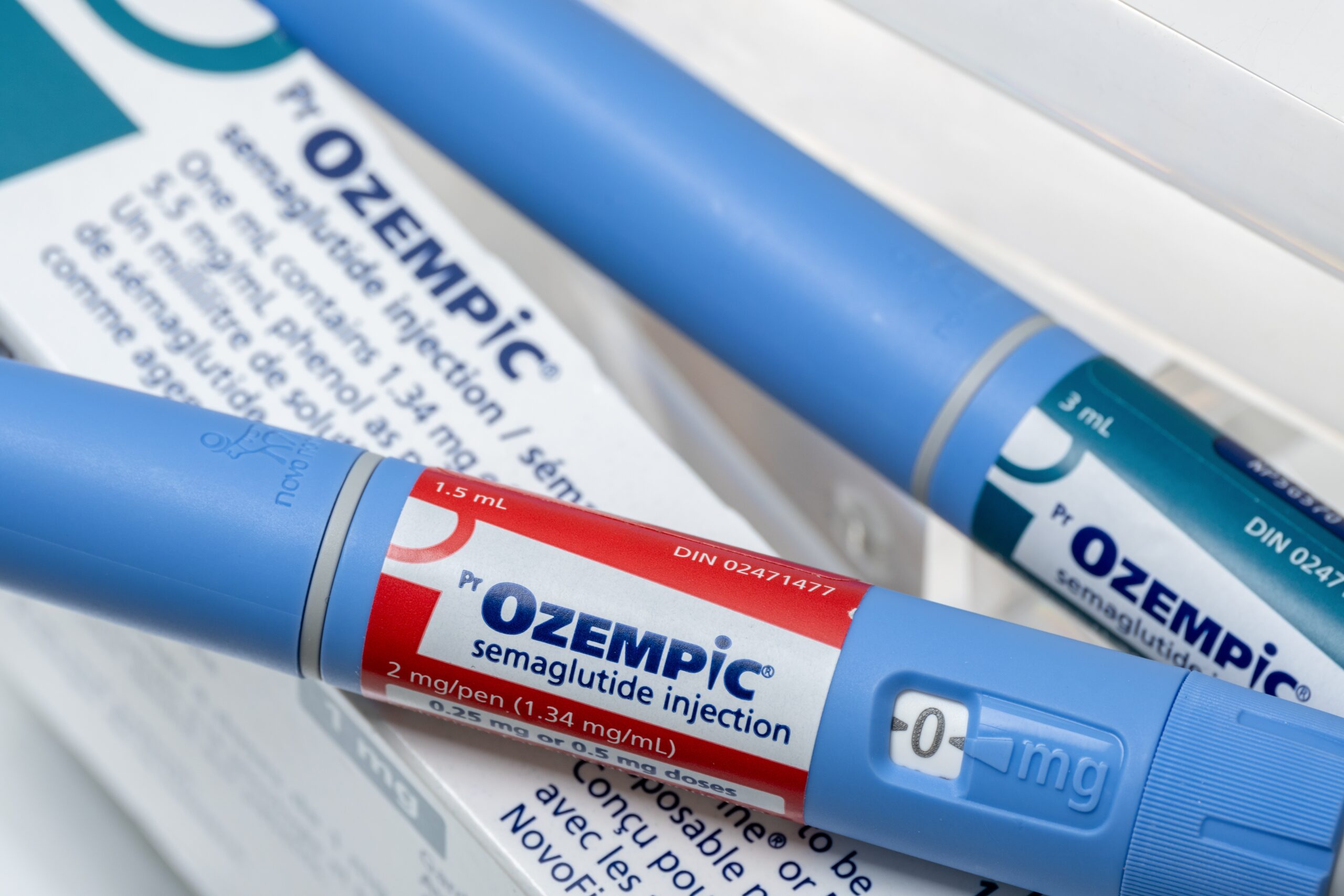We take a closer look at Ozempic and other weight loss medications, and how they might be helpful for people living with diabetes.
Thanks to worldwide hype about weight loss benefits, most of us are familiar with the once-a-week injectable medications for diabetes, which include Ozempic (semaglutide), Mounjaro (tirzepatide) and Wegovy (semaglutide – indicated for weight loss).
All of them contain hormones called incretins, which we will refer to as GLP-1.
Natural GLP-1s are largely produced in the gastrointestinal tract and last about 2-3 minutes. They have a few functions, including helping to regulate glucose and signalling to the pancreas to produce and release insulin when you’re eating.
The GLP-1s in these medications can last up to a week, “switching on” when we are eating or anticipating eating food.
How do GLP-1 medications such as Ozempic work?
GLP-1 medications reduce blood glucose levels by:
- Increasing insulin production in the body in response to food (for people with type 2 diabetes.)
- Reducing the production and release of stored glucose.
- Reducing gastric emptying (this means glucose is released more slowly.)
- Increasing insulin sensitivity (making insulin work better, so people with type 1 diabetes or type 2 diabetes who require insulin may need less.)
The medications contribute to weight loss by:
- Slowing down stomach emptying (helping you to feel full for longer.)
- Signalling fullness in the brain (reducing appetite.)
What are the benefits of using Ozempic and other GLP-1 medications for diabetes management?
These medications can improve glucose levels by reducing variability. People might find they are in target range more often, with fewer blood glucose spikes. As a result, you will hopefully see improved HbA1c (average glucose levels.)
This can lead to people with type 1 diabetes requiring less insulin. A large study of 1400 people with type 1 diabetes found that using GLP-1 medications reduced bolus insulin by 25-33% and basal insulin by 10-25%.
Keeping glucose levels within target range has cardiovascular benefits and reduces the risk of diabetes-related complications.
While weight loss is not the primary aim when using these medications for diabetes, it can be another benefit if you find it challenging to manage your weight. It might be useful in reducing weight around visceral organs, which can then help either injected or naturally produced insulin work more effectively as you are combating insulin resistance.
Are there any side effects?
Common side effects include nausea and vomiting, constipation and indigestion – although these symptoms are typically minimal and usually only when starting to take the medication or increasing the dose.
It is important to be aware of any mental health changes, as there is an increased risk of anxiety and depression.
Less common side effects include pancreatitis, optic neuropathy/retinopathy (damage to vision) and malnourishment.
Vision loss and GLP-1s
We have been seeing reports in the media recently of GLP-1 medications causing vision loss. However, we are lacking evidence of what exactly is causing this.
Sudden improvement of blood glucose levels via any treatment is linked with worsening of a condition called diabetic retinopathy (which can result in worsening or loss of vision). However, it’s not clear if this is the cause here, as they have also been linked with other eye conditions.
A recent study has emerged relating the risk of eye neuropathy (eye damage) to the uptake of Ozempic injections. So, let’s look at the research to understand if this is something to be concerned about.
The study was well organised, and did legitimately demonstrate an increased risk of eye damage in people taking Ozempic. This increased risk seemed to occur in the first 12 months after starting Ozempic, after which there was no increased risk. That being said, the study does have limitations that need further investigation, and there is limited research to support this finding.
As studies into Ozempic increase, we can expect to learn more about any potential side effects. At this stage, it would not be appropriate to make treatment decisions based on one study. If you are concerned about your medication you can talk to your doctor
We recommend having your eyes assessed prior to starting new diabetes medications, and checked regularly, even if your vision seems fine, or as soon as you notice any change to your vision.
Do I have to change my eating habits?
It’s worth consulting a nutritionist before starting GLP-1 medications to help set realistic expectations and reduce possible side effects in the early phase.
You may need to change your eating habits, not for weight loss, but to manage any side effects. An assessment will identify any nutrient deficiencies that you might already have, or that you could be at high risk of getting once you start taking these medications.
Improving nutrition before starting GLP-1 medications can provide positive benefits including:
- Diabetes management
- Weight management
- Sleep quality
- Improved quality of life
If lifestyle changes are successful, you may not need to use these medications. A recent studies show that exercise can also suppress your appetite.
If you do start taking one of these medications, there are two phases when what you eat can have a big impact.
Early phase (first 3-6 months)
Often this early phase is when the gastrointestinal (GI) side effects are at their strongest. Good nutrition is crucial due to a significant decrease in appetite and the risk of malnutrition. You may also experience a lack of energy, feel tired and lose lean muscle mass.
Nutrition tips for the early phase:
- Eat slowly and in smaller portions.
- Don’t lie down after eating.
- Stop eating when full.
- Avoid using a straw.
- Don’t eat too close to bedtime.
Long-term (ongoing after first 6 months)
Sometimes called the maintenance phase, by now all potential gastro-intestinal side effects have usually disappeared. Appetite has started to increase, but not to the level prior to starting the medication. Weight loss has started to decrease or even stopped and remained stable.
Nutrition tips for the longer term:
- Make non-starchy vegetables the focus (½ plate.)
- Have some lean protein at all main meals (¼ plate) and snacks, if needed.
- Eat high–fibre and low GI carbohydrate foods (¼ plate.)
- Drink plenty of water
- Eat fewer highly processed treat foods
- Eat until you feel comfortable, not full
- Limit distractions when eating.
How much protein should you be eating on GLP-1 medications?
Dietitian and credentialled diabetes educator Linda Bradbury points out that it’s important to consider your protein intake to prevent muscle mass over time when starting GLP-1 medications.
Eating adequate amounts of lean protein will keep you feel fuller for longer, regulate glucose levels (protein can slow digestion and reduce glucose spikes after meals) and, importantly, protect your muscle mass. Muscle mass is critical for our bone density, glucose metabolism and strength and balance in the long term.
Finally, keep in mind that GLP-1 medications are powerful tools, not magic pills. They work best with improved nutrition, physical activity and medical support. They are not suitable for everyone – individualised care is key.
This information is intended for general purposes only and should not be substituted for individual healthcare advice, diagnosis, management and treatment. Always seek the advice of your doctor or health professional if you have questions or concerns about your diabetes management.
Reference: Glucagon-like peptide-1 receptor agonists and type 1 diabetes: a potential game changer? – PMC




